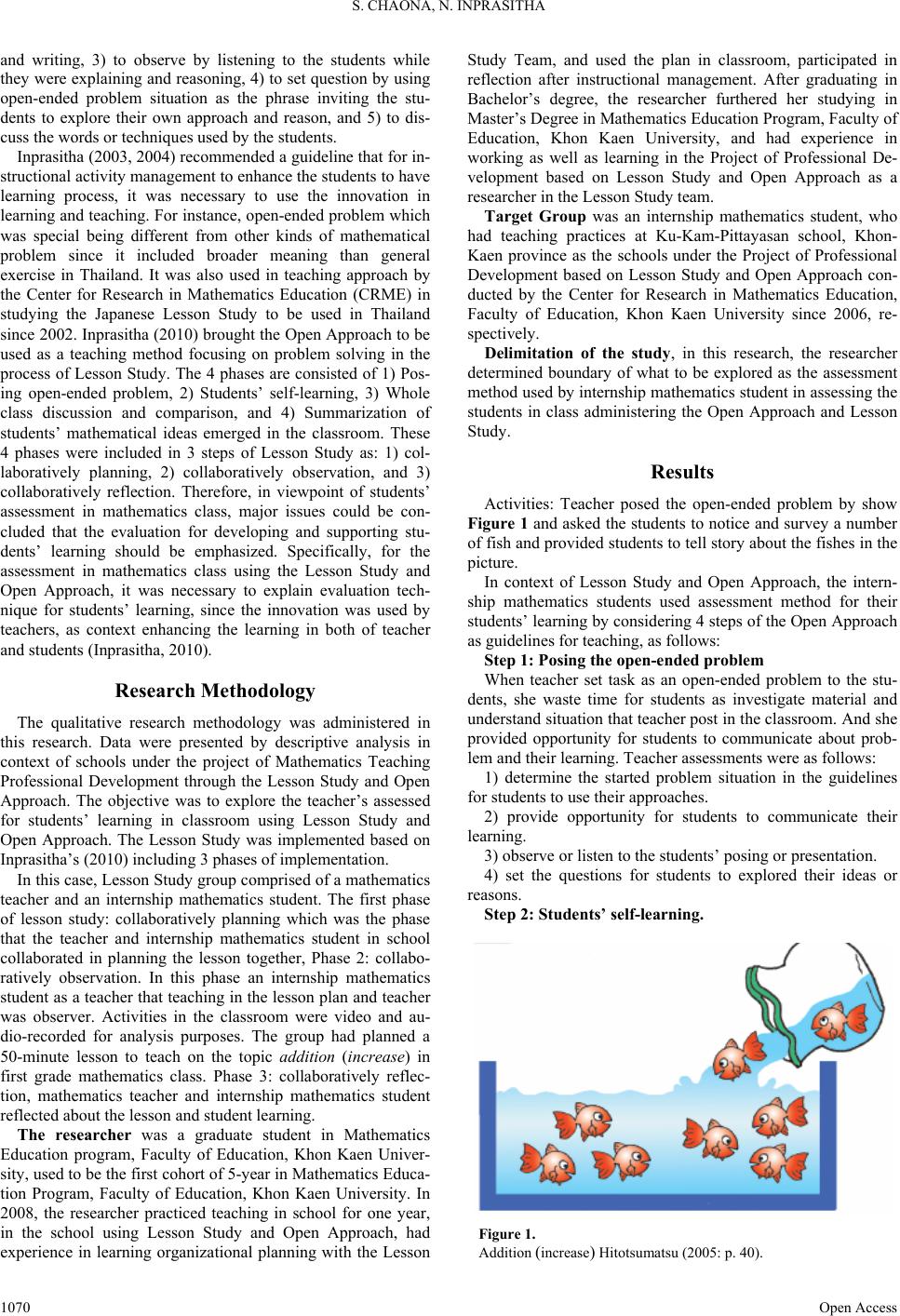
S. CHAONA, N. INPRASITHA
and writing, 3) to observe by listening to the students while
they were explaining and reasoning, 4) to set question by using
open-ended problem situation as the phrase inviting the stu-
dents to explore their own approach and reason, and 5) to dis-
cuss the words or techniques used by the students.
Inprasitha (2003, 2004) recommended a guideline that for in-
structiona l activ ity ma nageme nt to enhance the students to have
learning process, it was necessary to use the innovation in
learning and teaching. For instance, open-ended problem which
was special being different from other kinds of mathematical
problem since it included broader meaning than general
exercise in Thailand. It was also used in teaching approach by
the Center for Research in Mathematics Education (CRME) in
studying the Japanese Lesson Study to be used in Thailand
since 2002. Inprasitha (2010) brought the Open Approach to be
used as a teaching method focusing on problem solving in the
process of Lesson Study. The 4 phases are consisted of 1) Pos-
ing open-ended problem, 2) Students’ self-learning, 3) Whole
class discussion and comparison, and 4) Summarization of
students’ mathematical ideas emerged in the classroom. These
4 phases were included in 3 steps of Lesson Study as: 1) col-
laboratively planning, 2) collaboratively observation, and 3)
collaboratively reflection. Therefore, in viewpoint of students’
assessment in mathematics class, major issues could be con-
cluded that the evaluation for developing and supporting stu-
dents’ learning should be emphasized. Specifically, for the
assessment in mathematics class using the Lesson Study and
Open Approach, it was necessary to explain evaluation tech-
nique for students’ learning, since the innovation was used by
teachers, as context enhancing the learning in both of teacher
and students (Inprasitha, 2010).
Research Methodology
The qualitative research methodology was administered in
this research. Data were presented by descriptive analysis in
context of schools under the project of Mathematics Teaching
Professional Development through the Lesson Study and Open
Approach. The objective was to explore the teacher’s assessed
for students’ learning in classroom using Lesson Study and
Open Approach. The Lesson Study was implemented based on
Inprasitha’s (2010) including 3 phases of implementation.
In this case, Lesson Study group comprised of a mathematics
teacher and an internship mathematics student. The first phase
of lesson study: collaboratively planning which was the phase
that the teacher and internship mathematics student in school
collaborated in planning the lesson together, Phase 2: collabo-
ratively observation. In this phase an internship mathematics
student as a teacher that teaching in the lesson plan and teacher
was observer. Activities in the classroom were video and au-
dio-recorded for analysis purposes. The group had planned a
50-minute lesson to teach on the topic addition (increase) in
first grade mathematics class. Phase 3: collaboratively reflec-
tion, mathematics teacher and internship mathematics student
reflected about the lesson and student learning.
The researcher was a graduate student in Mathematics
Education program, Faculty of Education, Khon Kaen Univer-
sity, used to be the first cohort of 5-year in Mathematics Educa-
tion Program, Faculty of Education, Khon Kaen University. In
2008, the researcher practiced teaching in school for one year,
in the school using Lesson Study and Open Approach, had
experience in learning organizational planning with the Lesson
Study Team, and used the plan in classroom, participated in
reflection after instructional management. After graduating in
Bachelor’s degree, the researcher furthered her studying in
Master’s Degree in Mathematics Education Program, Faculty of
Education, Khon Kaen University, and had experience in
working as well as learning in the Project of Professional De-
velopment based on Lesson Study and Open Approach as a
researcher in the Less on Study team.
Target Group was an internship mathematics student, who
had teaching practices at Ku-Kam-Pittayasan school, Khon-
Kaen province as the schools under the Project of Professional
Development based on Lesson Study and Open Approach con-
ducted by the Center for Research in Mathematics Education,
Faculty of Education, Khon Kaen University since 2006, re-
spectively.
Delimitation of the study, in this research, the researcher
determined boundary of what to be explored as the assessment
method used by internship mathematics student in assessing the
students in class administering the Open Approach and Lesson
Study.
Results
Activities: Teacher posed the open-ended problem by show
Figure 1 and asked the students to notice and survey a number
of fish and provided students to tell story about the fishes in the
picture.
In context of Lesson Study and Open Approach, the intern-
ship mathematics students used assessment method for their
students’ learning by considering 4 steps of the Open Approach
as guidelines for teaching, as follows:
Step 1: Posing the open-ended proble m
When teacher set task as an open-ended problem to the stu-
dents, she waste time for students as investigate material and
understand situation that teacher post in the classroom. And she
provided opportunity for students to communicate about prob-
lem and thei r le arning. Teacher assessments were as follows:
1) determine the started problem situation in the guidelines
for students to use their approaches.
2) provide opportunity for students to communicate their
learning.
3) observe or listen to the students’ posing or presentation.
4) set the questions for students to explored their ideas or
reasons.
Step 2: Students’ self-learning.
Figure 1.
Addition (increase) Hitotsumatsu (2005: p. 40).
Open Access
1070